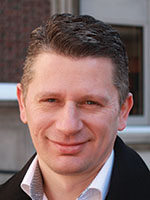2015 Janet Taylor Spence Award

Dean Mobbs
Columbia University
What is the focus of your award-winning research?
My research attempts to answer three broad sets of questions:
- What are the neurobiological and behavioral phenotypes that underlie fear and anxiety? How do we learn to control our fears, and how does this process go awry in anxiety disorders? To answer these questions, my research examines how changing the intensity of threat (e.g., near or far threats) result in switches from slow cortical brain regions to fast midbrain regions involved in fight or flight, how these neural systems mutually inhibit each other, and how the harmony between these circuits predicts optimal or suboptimal expression of fear.
- How can we determine the behavioral and neural signatures of positive social interactions, such as observing why others’ success is rewarding (e.g., vicarious reward and reflected glory), altruism, and empathy. And how do these positive interactions mask seemingly selfish motives that manifest in the form of envy and schadenfreude?
- What is the interplay between social interaction and emotion? For example, how does fear change when we are in a group versus alone? How does the protective value of others reduce our fear?
These questions are embedded in theoretical models developed by my lab as well as in theories from the diverse fields of behavioral ecology, social psychology, evolutionary biology, and affective science.
How did you develop an interest in this area?
Social psychology and affective science are about the everyday experiences we all encounter and about humanity, including what moves us, relationships, and meaning. My interest in these questions was ignited by reading the faultless work of Michael Fanselow, Caroline and Robert Blanchard, Lisa Feldman Barrett, Jaak Panksepp, Joe LeDoux, Liz Phelps, Ralph Adolphs, Brian Knutson, Matt Lieberman, and Naomi Eisenberger. These researchers had a major impact on the development of my research interests and direction. Less obvious influences come from my love of zombie, sci-fi, and end-of-the-world movies. These movies open up interesting questions concerning fear, survival, and what happens to human relationships when society dissolves. Ideas for several published papers have come from watching movies.
Who are your mentors and/or biggest psychological influences?
My biggest influences are my wife, Cindy Hagan, also a cognitive neuroscientist and sounding board for all my research, and my brother, Karl Mobbs, who inspired me to reeducate myself as an adult. Another big influence is Allan Reiss at Stanford University. When I was an RA, Allan put faith in me to run research projects, analyze data, and write up papers. I ended up publishing six first-author papers as an RA, and I am eternally grateful for this opportunity and his support. In graduate school, I was lucky to work with Chris Frith and Ray Dolan — both were wonderful and incisive mentors who further shaped my approach to science. I was also very lucky to have Demis Hassabis as a colleague; without him, my studies would probably look different. My time at University College London was special because I was surrounded by many amazing people including Predrag Petrovic, Henrik Ehrsson, Tania Singer, John O’Doherty, Hakwan Lau, Tom Schofield, Ben Seymour, Christian Ruff, and others. I can’t imagine a more exciting place to learn. At Cambridge, Tim Dalgleish and Andy Calder, both my postdoctoral advisors, played a critical part in the development of my scientific career. Other wonderful colleagues and collaborators include Bernhard Staresina, Michael Ewbank, Adrian Owen, Jess Grahn, Tristan Bekinschtein, and Hidehiko Takahashi. My colleagues at Columbia University have also been a major inspiration, including Kevin Ochsner, who has been a wonderful colleague and friend, as have Walter Mischel, Tory Higgins, Geraldine Downey, Carl Hart, Daphna Shohamy, Nim Tottenham, Valerie Purdie-Vaughns, Janet Metcalfe, James Curley, Francis Champagne, and Sarah Woolley. Finally, I have worked with many amazing students including Oriel FeldmanHall, Rongjun Yu, Owen Footer, Song Qi, Charlotte Prevost, and Ellen Tedeschi. All have inspired me in ways they probably underestimate.
What unique factors have contributed to your early success?
I think it’s my optimism, sheer persistence, motivation when searching for ideas, and the anticipatory excitement of unearthing something undiscovered. The quality of an idea sets the foundation for the tensile excitement and success of the experiment — rarely has a good study started with a bad idea. To use a musical analogy, I see the idea as the song’s melody, the methods as the instruments, and the paper as the lyrics. I have tried to master each of these processes, yet I will always be learning with joy. It is important to note that my experiments are not always successful, and this can be risky — especially prior to tenure — yet playing it safe rarely results in anything interesting. I live by the principle that I would rather be courageous and fail trying than do research that fails to capture the minds of others.
What does winning this award mean to you both personally and professionally?
I do science because I love the creative process where one takes an idea from a simple everyday observation, forms a question, and articulates this question through the scientific method. I am genuinely delighted to win this award, yet I feel lucky enough to be in the position I am in at Columbia University and to work in a field with talented researchers who are at the frontier of new discoveries concerning human nature. How amazing is that?!

